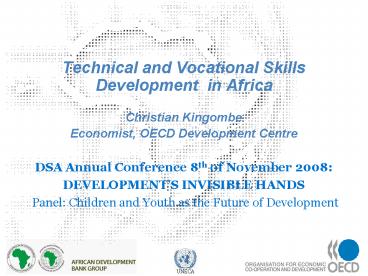Technical and Vocational Skills Development in Africa - PowerPoint PPT Presentation
1 / 15
Title:
Technical and Vocational Skills Development in Africa
Description:
Strengths and weaknesses of various TVSD modalities and actors ... between training institutions & businesses is the Mubarak-Kohl Initiative (MKI) ... – PowerPoint PPT presentation
Number of Views:164
Avg rating:3.0/5.0
Title: Technical and Vocational Skills Development in Africa
1
- Technical and Vocational Skills Development in
Africa - Christian Kingombe
- Economist, OECD Development Centre
- DSA Annual Conference 8th of November 2008
- DEVELOPMENTS INVISIBLE HANDS
- Panel Children and Youth as the Future of
Development
2
Outline
- Purpose and Key questions
- Definition of Technical and Vocational Skills
Development (TVSD) concept - Strengths and weaknesses of various TVSD
modalities and actors - Statistics Enrolment and Access at the secondary
level - Challenges in specific socio-economic contexts
- Lessons Learnt from good practices 7 major
pillars of TVSD strategy - Main message.
3
Purpose and Key questions
- The purpose of the special focus for this 7th
edition of the African Economic Outlook report is
to provide a snapshot of the approaches,
experience and prospects of Technical and
Vocational Skills Development (TVSD) in Africa at
the secondary school level (ISCED2-3). - Key Questions
- What role for TVSD in Africa today?
- What is the status of skills development?
- Which providers and what access?
- Are skills gaps being adequately addressed?
- What are the lessons learned from recent reforms ?
4
Definition
Technical and vocational skills development
Acquisition of knowledge, practical competences
knowhow
Workplace training in enterprises
Informal Apprenticeship
Public or private TVET schools
Dual Training
Degree of formalization of labour market
Formal
Informal
5
TVSD
Who provides training?
9
6
Enrolment in Secondary Technical and Vocational
Training International Comparison
ISCED 23
Source OECD Development Centre / UNESCO-UIS
(2006), 2008
7
ACCESS
Formal Training, Only 5 of Students
African countries can be grouped in three
categories Group I Proportion of TVET
enrolment gt 10. Group II Proportion of TVET
enrolment between 5 and 9. Group III
Proportion of TVET enrolment lt5. Others Data
not available
Percentage of total secondary students enrolled
in technical and vocational programmes in 2005
Source OECD Developemnt Centre / UNESCO, Global
Education Digest, 2007
8
Lessons Learnt
Constraints on TVSDs impact expansion
TVSD
Missing links
Weak links
Post-secondary and tertiary institutions
Industry skills needs
Firm-based and informal training
National development policy
Lack of a coherent strategic approach
9
Challenges
TVSD in specific contexts
- 1. Youth unemployment
- 133 million young people (gt50 of youth
population) in Africa are illiterate. - Many young people have little or no skills with
no prospects for decent work. - Incidence of youth unemployment in SSA gt20.
- 2. Fragile states
- Many risk becoming trapped in a cycle of
violence, often because of lack of educational
and employment opportunities. - TVSD is a vital part of reintegration and
reconstruction in post-conflict situations - 3. Migration
- Brain drain High rates of emigration among
highly skilled workers. - Emigration can benefit home countries through
remittances, investments, diaspora networks,
circular migration.
10
Good Practices
Vision and Planning
- Adopting an integrated vision and clear lines of
authorities - Senegal Launched a TVSD reform making the TVSD a
tool for competitiveness - Zambia clear legal and regulatory framework
Technical, Vocational and Entrepreneurship
Training Authority, 2005 - Yet in many cases it remains difficult to
identify the leading institution. - Training authorities need to be given clear
mandate and authority over resources. - 2. Improving Forecasting and Planning for Skills
Needs - Successful TVSD reforms include
- Long-term planning skill audits (Rwanda)
- Monitoring and Evaluation mechanisms
- Benin Labour Market Observatory (tracking
graduates, Labour Market survey)
11
Good Practices
Quality Improvement Informal Economy
- 3. Improving the quality of TVSD
- Switch to demand-driven training model.
- TVET National Qualification Framework (NQF)
- Ethiopia New Quality Management System (2006)
- South Africa A new statement for the NQF was
developed to enhance the efficacy and efficiency
(2007)- involving users and providers. - 4. Addressing the informal sectors skill needs
(and those of vulnerable groups) - In view of its large size, Training in the
informal sector should be recognised. - Benin Test, certification of skills acquired
through traditional apprenticeship (Vocational
Skill Certificate). - Senegal Pilot scheme to transform traditional
apprenticeship into a dual system.
12
Good Practices
Innovation Partnership
- 5. Setting up accompanying measures
- Design of integrated programs that couple
training with access to finance, Business
development services, Marketing support, network - AfDB ILO Support to growth oriented women
entrepreneurs (GOWE). - Angola First Job Law Active labour mkt policies
to facilitate transition to work (internships, 60
per cent contribution to salary, support SMEs
creation) - 6. Foster Partnership with All stakeholders
- Policy design and actual delivery of education
and training can best be achieved through a
partnership between government, social partners
and various stakeholder groups in the formal and
informal sectors of the economy - Mauritius Tunisia strong partnership with
private sector - Egypt The most successful example of PPP between
training institutions businesses is the
Mubarak-Kohl Initiative (MKI).
13
Good Practices
Local Communities Management
- 7. Involving Local Communities and Strengthening
Local Management of TVSD - Delegation of responsibilities to regional
authorities. - Ethiopia Consider establishing autonomous TVET
Authorities at federal and state levels, governed
by TVET Council. - Tunisia The decentralization process is based on
the devolution of responsibilities to the
training centres. - But...
- in many countries local authorises and school
management have insufficient pedagogical,
managerial, and administrative capacity to
discharge new responsibilities - Mozambique School Advisors
14
Key Message
AEO
- To be fully effective, TVSD strategies
- Must be integrated into comprehensive employment
policies, and - focus on sectors experiencing employment growth
and skills shortages
15
- Thank you
- More information
- www.oecd.org/dev/aeo
- www.afdb.org































